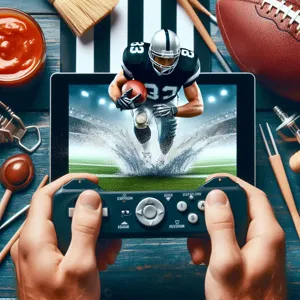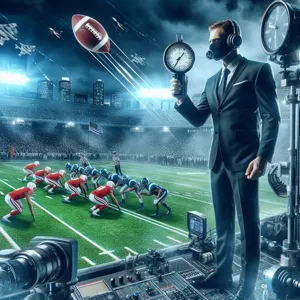In the world of soccer, the role of the referee is often overshadowed by the players and coaches, yet it is one of the most critical positions on the field.
A skilled referee can make the difference between a fair match and one riddled with controversy, impacting the game’s outcome and the players’ experiences. As soccer continues to evolve and attract millions of passionate fans globally, the need for high-quality officiating has never been more pressing. This blog post delves into effective strategies to enhance referee quality, from comprehensive training programs and mentorship opportunities to the integration of technology and improved communication methods. By focusing on these key areas, we can ensure that referees are equipped to make informed decisions, uphold the integrity of the game, and ultimately level the playing field for all participants. Join us as we explore these strategies and their potential to transform the officiating landscape in soccer, fostering a more fair and enjoyable experience for players and fans alike.
1. The Importance of Quality Refereeing in Soccer

In the world of soccer, the referee often stands as the unsung hero or the villain, depending on the outcome of a match. Yet, the importance of quality refereeing cannot be overstated. A skilled referee does more than just enforce the rules; they serve as the backbone of fair play, ensuring that the game flows smoothly and that all players have an equal opportunity to showcase their talent.
Imagine a high-stakes match where every pass and tackle is scrutinized. The referee’s ability to make accurate and timely decisions can significantly impact the game’s outcome. A well-refereed match fosters trust among players, coaches, and fans, creating an environment where the spirit of the game thrives. Conversely, poor refereeing can lead to frustration, controversy, and even violence on the pitch, undermining the integrity of the sport.
Quality refereeing also enhances player development. When young athletes experience a consistently fair and knowledgeable officiating team, they learn to respect the game and its rules, instilling values of discipline and sportsmanship. Moreover, it encourages them to play to their full potential without the fear of unfair treatment or bias. This positive experience translates into a healthier, more competitive environment that benefits the sport as a whole.
Ultimately, the significance of quality refereeing goes beyond the confines of the stadium. It is about maintaining the essence of soccer—passion, fairness, and respect. As we explore strategies to enhance referee quality, it is crucial to recognize the pivotal role they play in shaping the future of the game. By investing in better training, support systems, and recognition for referees, we can ensure that every match is a true reflection of the beautiful game.
2. Common Challenges Faced by Soccer Referees
Refereeing soccer is not just about knowing the rules; it’s about navigating a complex landscape of challenges that can impact the game and the officials’ performance. One of the most significant hurdles referees face is the intense pressure from players, coaches, and fans. The emotional stakes in soccer are high, and this often translates into vocal criticism, which can be overwhelming, especially for those new to officiating. The constant scrutiny means that referees must maintain composure and confidence, even when faced with dissenting opinions.
Another challenge is the physical demands of the game. Referees must keep up with the fast pace of play, requiring not only good fitness levels but also a keen awareness of positioning to make accurate calls. This physicality is compounded by the need to maintain focus for the duration of the match, as a momentary lapse can lead to missed fouls or offside violations, resulting in repercussions on the field.
Communication is also a crucial yet challenging aspect of refereeing. Referees must effectively communicate decisions to players and coaches, ensuring that everyone understands the rationale behind their calls. This can be particularly tricky when emotions run high and players may be less receptive to explanations. Additionally, language barriers can pose significant challenges in diverse leagues where officials and players come from various backgrounds.
Lastly, the rapid evolution of the game, including the introduction of technology like VAR (Video Assistant Referee), presents its own set of complexities. While VAR aims to enhance fairness in officiating, it can also create confusion and lead to contentious debates over decisions. Referees must adapt to these changes, continually updating their skills and knowledge to effectively incorporate technology into their officiating.
By acknowledging these common challenges, we can better understand the need for comprehensive training and support systems to enhance referee quality in soccer, ultimately leading to a better experience for players and fans alike.
3. Strategies for Better Training and Development

### 3. Strategies for Better Training and Development
Enhancing the quality of referees in soccer is not just about maintaining discipline on the field; it’s about fostering a deep understanding of the game and instilling confidence in officiating decisions. The training and development of referees play a critical role in achieving this goal. Here are some effective strategies to elevate referee training, ensuring that officials are well-prepared to handle the nuances of the game.
**Comprehensive Training Programs:** Developing a structured training program is essential for all levels of referees, from grassroots to professional. These programs should encompass not only the rules of the game but also situational awareness, conflict resolution, and communication skills. Incorporating video analysis of actual game scenarios can provide referees with practical insights, allowing them to learn from real-life situations and improve their decision-making skills.
**Mentorship and Peer Review:** Establishing a mentorship system can greatly benefit novice referees. Pairing inexperienced officials with seasoned referees allows for the exchange of knowledge and experience. Regular feedback sessions, where referees can discuss their performances and areas for improvement, create an environment of continuous learning. This also fosters a sense of community and support among officials, promoting a culture of growth and development.
**Continuous Education:** The world of soccer is always evolving, and so are the rules and regulations that govern the game. Implementing a system of continuous education, with regular workshops and refresher courses, ensures that referees stay updated on the latest changes in the laws of the game. This could include online modules, in-person seminars, or even engaging in discussions with experienced referees to share their insights on recent developments.
**Physical Fitness and Mental Resilience:** A referee’s performance is not solely based on knowledge of the game; physical fitness and mental resilience also play crucial roles. Incorporating fitness training tailored specifically for referees can enhance their stamina and agility on the field. Additionally, workshops on mental resilience can equip officials with techniques to manage stress and pressure during high-stakes matches, enabling them to maintain focus and composure.
**Incorporating Technology:** Leveraging technology in training can help refine the skills of referees. Video analysis tools can be used to break down match footage, allowing officials to analyze their positioning, decision-making, and interactions with players. Additionally, virtual reality training programs can simulate game situations, giving referees the opportunity to practice their responses in a controlled environment.
By implementing these strategies, soccer organizations can significantly enhance the training and development of referees, ultimately leading to improved officiating quality on the field. Investing in the growth of referees not only elevates the standards of the game but also contributes to a more fair, enjoyable, and respected sporting experience for players and fans alike.
4. The Role of Mentorship in Referee Improvement
Mentorship plays a pivotal role in the development and improvement of soccer referees, serving as a cornerstone for fostering skill enhancement and confidence on the field. Just as players benefit from guidance and support, referees too thrive in an environment where experienced officials share their wealth of knowledge and practical insights. This relationship not only accelerates learning but also deepens the understanding of the game’s intricacies, ensuring that new referees are well-equipped to handle the fast-paced and often intense nature of soccer matches.
A strong mentorship program pairs novice referees with seasoned officials who can provide one-on-one coaching, offering real-time feedback during games and constructive critiques in a safe, supportive environment. This dynamic allows mentees to ask questions, discuss challenging scenarios, and learn effective decision-making techniques that can only be honed through experience. Moreover, mentors can help them navigate the often-complex rules of the game, making sure they grasp the nuances that can influence match outcomes.
In addition to technical skills, mentorship fosters a sense of community and belonging within the officiating ranks. New referees often face considerable pressure and scrutiny, and having a mentor to lean on can significantly boost their morale and resilience. This support system encourages open dialogue about challenges faced during games, helping mentees to develop coping strategies and a healthy mindset.
Furthermore, mentorship should not be a one-way street. Experienced referees also benefit from fresh perspectives and the enthusiasm of new referees. This exchange of ideas can lead to innovative approaches to officiating, enhancing the overall quality of refereeing in the sport. By investing in mentorship programs, soccer organizations can cultivate a new generation of capable and confident referees, ensuring the integrity of the game while elevating the standard of officiating at all levels.
5. Utilizing Technology to Support Referees

In the fast-paced world of soccer, where split-second decisions can dramatically influence the outcome of a match, leveraging technology to support referees has become essential. The integration of advanced tools not only enhances the accuracy of officiating but also instills confidence in both players and fans alike.
One of the most significant technological advancements is the Video Assistant Referee (VAR) system. This innovative approach allows on-field referees to consult with a team of officials who review crucial moments in real-time. By utilizing multiple camera angles to assess plays such as goals, penalty decisions, and red card incidents, VAR aims to minimize human error and ensure that the correct calls are made. However, the technology’s effectiveness hinges on proper training for referees, so they can seamlessly incorporate VAR into their match officiating without disrupting the flow of the game.
Beyond VAR, other technologies, such as goal-line technology, provide additional layers of support. This system uses cameras and sensors to determine whether the ball has completely crossed the goal line, thus eliminating the age-old debate over close calls. By removing the ambiguity surrounding goals, referees can focus on other aspects of the game, knowing they have reliable support for these critical decisions.
Moreover, wearable technology, like communication devices and fitness trackers, plays a vital role in enhancing referee performance. With earpieces that allow instant communication among officiating teams, referees can share insights and coordinate their decisions more effectively. Fitness trackers can help officials monitor their physical condition during matches, ensuring they remain fit and positioned correctly to make accurate calls.
Incorporating these technologies is not merely about embracing innovation; it is about fostering an environment where referees feel supported and empowered to make the right decisions. As technology continues to evolve, so too will the ways in which it can enhance the quality of officiating in soccer, ultimately leading to a fairer and more enjoyable experience for everyone involved in the game.
6. Creating a Supportive Referee Culture
Creating a supportive referee culture is essential for enhancing the quality and integrity of officiating in soccer. This culture goes beyond mere acknowledgment of referees’ roles; it involves fostering an environment where referees feel valued, respected, and empowered to perform at their best.
To cultivate this supportive atmosphere, associations and clubs must prioritize open communication and mutual respect between players, coaches, and referees. Initiatives such as pre-season meetings that include referees can help establish a clear understanding of expectations and foster camaraderie. When players and coaches recognize referees as integral members of the soccer community, it sets the stage for a more positive interaction on the field.
Training programs that incorporate mentorship are also vital. Experienced referees can guide newcomers, sharing insights and strategies while providing a safe space for questions and growth. This mentorship not only helps young referees develop their skills but also strengthens the bond within the officiating community, creating a sense of belonging and support.
Moreover, public recognition of referees’ contributions plays a crucial role in building a supportive culture. Celebrating referees during games, featuring them in club newsletters, or highlighting their achievements on social media can uplift their spirits and reinforce their importance in the game. When referees feel appreciated, they are more likely to be confident in their decisions and committed to continuous improvement.
Lastly, fostering a culture of constructive feedback is paramount. Instead of criticism, clubs should emphasize learning and development. Establishing regular review sessions where referees can discuss challenges and successes with their peers creates an environment of growth and resilience. By encouraging a mindset that views mistakes as opportunities for learning, the overall quality of officiating can improve dramatically.
In summary, creating a supportive referee culture requires commitment from everyone involved in soccer—from coaches to players to the clubs themselves. By valuing referees, providing mentorship, celebrating their contributions, and promoting constructive feedback, we can enhance the quality of officiating and, in turn, elevate the beautiful game as a whole.
7. Enhancing Physical Fitness and Conditioning

### 7. Enhancing Physical Fitness and Conditioning
In the fast-paced world of soccer, the role of a referee is as demanding as that of the players on the field. To maintain control over the game, make accurate decisions, and ensure player safety, referees must possess not only sharp mental acuity but also exceptional physical fitness. Enhancing the physical conditioning of referees is crucial to elevating the overall quality of officiating in soccer.
Referees are required to cover significant distances during a match, often running several miles while maintaining the agility to position themselves optimally for key plays. This level of activity necessitates a well-structured fitness regimen that prioritizes cardiovascular endurance, strength, flexibility, and agility. Implementing a training program tailored specifically for referees can help improve their on-field performance and decision-making capabilities.
Incorporating interval training can boost cardiovascular endurance, allowing referees to recover quickly between high-intensity bursts of activity, such as sprinting to keep up with the play. Strength training exercises focused on core stability and leg power can enhance a referee’s ability to maintain balance and tackle the physical demands of the game. Furthermore, flexibility training, including dynamic stretching and yoga, can help prevent injuries and improve overall mobility.
Regular fitness assessments can also be invaluable. By tracking progress in areas like sprint speed, endurance levels, and recovery times, referees can adjust their training plans to ensure they are always in peak condition. Additionally, workshops and clinics focused on the importance of nutrition and recovery strategies can further support referees in maintaining their health and fitness.
Ultimately, enhancing physical fitness and conditioning is not just about improving a referee’s performance; it enhances the integrity of the game. A fit referee can make quicker, more accurate decisions and maintain the stamina needed to officiate throughout the match. As soccer continues to evolve, prioritizing the physical development of referees will play a significant role in leveling the playing field and ensuring that every match is officiated with the highest standards of professionalism.
8. Implementing Regular Feedback and Assessment
Implementing regular feedback and assessment is crucial for elevating the quality of refereeing in soccer. Just as players and coaches thrive on constructive criticism to hone their skills, referees benefit immensely from a structured feedback mechanism. Establishing a culture of continuous improvement through regular evaluations ensures that officials are not only held accountable but also empowered to grow in their roles.
To start, leagues and governing bodies should institute a systematic approach to performance reviews. This can involve post-match assessments where experienced referees or assigners observe and critique officiating decisions. Utilizing video analysis can further enhance this process; referees can review game footage to identify areas of strength and opportunities for improvement. By breaking down specific moments of the match, such as critical calls or positioning, referees gain valuable insights that can refine their judgment and enhance their decision-making capabilities in future matches.
Additionally, fostering an open dialogue between referees and their assessors is essential. Constructive discussions about performance can help demystify the often-challenging aspects of officiating, allowing referees to express their perspectives and learn from their experiences. Encouraging referees to set personal goals based on feedback not only motivates growth but also instills a sense of ownership over their development.
Moreover, creating a mentorship program can further bolster the learning process. Pairing less experienced referees with seasoned officials can provide invaluable guidance and support. Mentorship encourages a culture of sharing knowledge and best practices, ultimately leading to a more skilled and confident officiating pool.
In conclusion, regular feedback and assessment are vital components in the quest to improve referee quality in soccer. By prioritizing continuous learning, fostering open communication, and implementing structured evaluation systems, the officiating landscape can be significantly enhanced, leading to fairer play and a better experience for players, coaches, and fans alike.
9. Promoting Diversity and Inclusion in Refereeing
Promoting diversity and inclusion in refereeing is essential for the growth and integrity of soccer as a sport. A diverse pool of referees brings varied perspectives, experiences, and backgrounds, enriching the officiating landscape and fostering a more inclusive environment for players and fans alike. When referees reflect the diversity of the communities they serve, they are better equipped to understand and manage the dynamics of the game, ensuring that all players feel represented and respected on the field.
To promote diversity in refereeing, organizations must actively seek to recruit individuals from underrepresented groups. This can involve outreach programs aimed at young people in diverse communities, providing workshops and training sessions to introduce them to the world of officiating. Mentorship programs can also play a vital role, pairing aspiring referees with experienced officials who can guide them through the challenges of the profession and help them build the confidence needed to succeed.
Inclusion goes beyond recruitment; it requires creating a supportive environment where all referees feel valued and empowered. This can be achieved by instituting policies and practices that promote equity in appointments, training opportunities, and career advancement. Regular diversity training for all officiating staff can help combat unconscious biases and create a culture of respect and understanding within refereeing teams.
Furthermore, showcasing diverse referees at high-profile matches not only serves as inspiration for aspiring officials but also sends a powerful message about the sport’s commitment to inclusivity. By highlighting the achievements of referees from various backgrounds, soccer organizations can help shift perceptions and encourage more individuals to consider officiating as a viable career path.
Ultimately, promoting diversity and inclusion in refereeing will enhance the quality of officiating itself, leading to more equitable and fair play on the field. As soccer continues to evolve, embracing the richness of diversity within its ranks is not just a goal but a necessity for ensuring the sport thrives for generations to come.
10. Engaging the Community and Stakeholders
Engaging the community and stakeholders is a crucial strategy in enhancing the quality of refereeing in soccer. When referees are viewed as integral members of the soccer community, their development and support become a collective responsibility. This collaborative approach not only fosters a deeper appreciation for the role of referees but also encourages a more positive atmosphere around officiating.
Start by hosting community workshops and training sessions that include not only referees but also coaches, players, and parents. These events can serve as forums for discussing the challenges referees face and the skills required to make sound judgments on the field. When stakeholders understand the intricacies of refereeing, they are more likely to show patience and empathy towards officials, leading to a more harmonious environment during matches.
Additionally, involving local soccer clubs and associations in the recruitment and mentorship of referees can create a robust support network. By connecting experienced officials with newcomers, you provide a pathway for knowledge transfer, skill development, and confidence building. This mentorship can extend beyond the field, with experienced referees sharing their insights during community meetings, thereby demystifying the officiating process.
Furthermore, consider establishing a recognition program that highlights exceptional refereeing within the community. Celebrating the efforts of referees not only boosts morale but also raises the profile of the officiating profession. Recognition can take many forms, from awards at local tournaments to features in community newsletters, and can significantly enhance the perception of referees as respected leaders in the sport.
Lastly, fostering open lines of communication between referees and the community is essential. This can be achieved through regular feedback sessions and surveys that allow stakeholders to voice their thoughts and experiences regarding officiating. By actively listening to the community and adapting to their concerns, referees can better align their practices with the expectations of players, coaches, and fans, ultimately leading to an enriched soccer experience for all involved.
Engaging the community and stakeholders is not just about improving the quality of refereeing; it’s about nurturing a culture of respect, understanding, and collaboration that benefits the entire soccer ecosystem. When everyone is invested in the success of referees, the positive ripple effects can be felt throughout the sport, leading to enhanced performance on the field and a stronger, more unified soccer community.
11. Establishing Clear Guidelines and Standards
Establishing clear guidelines and standards is crucial in enhancing referee quality in soccer, as it lays the groundwork for consistent decision-making and fosters an environment of respect and professionalism on the field. First and foremost, these guidelines should delineate the roles and responsibilities of referees, ensuring they understand the expectations placed upon them. This includes not just their duties during a match, but also their responsibilities in terms of communication, conflict resolution, and post-match analysis.
Moreover, comprehensive standards should be developed for training and evaluation. Regular workshops and seminars can be invaluable, providing referees with updated knowledge of the laws of the game, as well as the latest trends in officiating. Incorporating simulation training, where referees can practice decision-making in realistic scenarios, can also help them build confidence and improve their judgment under pressure.
Additionally, establishing a clear system for feedback and evaluation is essential. Referees should receive constructive criticism from experienced officials and coaches after matches, allowing them to learn from their experiences and identify areas for improvement. This feedback loop not only aids in professional growth but also promotes accountability within the officiating community.
Lastly, it is vital to ensure that all guidelines and standards are communicated effectively across all levels of play, from youth leagues to professional matches. By fostering a uniform understanding of these expectations, we can cultivate a culture of respect for referees, ultimately leading to improved officiating standards and a better experience for players and fans alike. When referees are equipped with the right tools and knowledge, they can confidently make decisions that uphold the integrity of the game.
12. Encouraging Continuous Education and Learning
In the fast-paced world of soccer, the role of a referee is not just to enforce the rules but to interpret them in the context of the game as it evolves. To ensure that referees are equipped to handle the complexities of modern soccer, encouraging continuous education and learning is paramount.
Refereeing is a discipline rooted in both knowledge and experience, and as such, it requires an ongoing commitment to professional development. This can be achieved through a variety of means, including workshops, seminars, and online training courses that delve into the latest rule changes, game management techniques, and best practices for officiating. Regularly scheduled refresher courses can also help to reinforce essential skills and introduce referees to new tools and technologies that enhance their performance on the field.
Moreover, mentorship programs can play a critical role in fostering growth among referees. Pairing seasoned officials with those who are newer to the game allows for the sharing of invaluable insights and firsthand experiences. This relationship not only builds confidence in emerging referees but also instills a sense of community within the officiating ranks, encouraging them to learn from one another.
Additionally, promoting a culture of feedback is essential. Implementing post-match reviews where referees can assess their decisions, discuss challenges faced during the game, and receive constructive criticism from peers or supervisors can significantly improve their decision-making skills.
By investing in continuous education and learning opportunities, soccer organizations can ensure that referees are not just good but great. This commitment to development will enhance their ability to make accurate calls, manage players effectively, and ultimately contribute to a more fair and enjoyable game for everyone involved.
13. Strategies for Handling Pressure and Conflict
In the fast-paced and emotionally charged arena of soccer, referees often find themselves at the center of intense scrutiny and pressure. The ability to manage this stress effectively is crucial for maintaining control of the game and ensuring fairness on the field. Developing strategies for handling pressure and conflict can not only enhance a referee’s performance but also contribute to a more positive atmosphere for players, coaches, and spectators alike.
One effective approach is to cultivate strong communication skills. Clear and assertive communication can prevent misunderstandings and help diffuse tense situations before they escalate. Referees should practice articulating their decisions calmly and confidently, using non-verbal cues and body language to reinforce their authority. By establishing rapport with players and coaches, referees can foster an environment of respect that makes it easier to navigate conflicts when they arise.
Another vital strategy is to focus on self-care and mental preparation. Referees can benefit from techniques such as mindfulness, deep breathing exercises, or visualization to calm nerves and enhance focus before and during matches. By taking the time to mentally prepare and ground themselves, referees can maintain composure and make more rational decisions, even when faced with high-pressure situations.
Additionally, seeking feedback and engaging in debriefs after matches can be invaluable. Constructive criticism from peers, mentors, or even players can provide insights into areas of improvement and help referees learn to handle similar situations more effectively in the future. Embracing a growth mindset allows referees to view challenges as opportunities for development rather than insurmountable obstacles.
Lastly, it is essential for referees to develop a strong support network. Connecting with fellow officials, joining local referee associations, or participating in workshops can provide a sense of community. This network can offer both emotional support and practical advice, equipping referees with the tools they need to handle pressure and conflict with grace and professionalism.
By implementing these strategies, referees can enhance their ability to manage stress and conflict, leading to more confident officiating and improved game management. Ultimately, when referees are equipped to handle pressure effectively, the entire soccer experience— for players, coaches, and fans— becomes more enjoyable and fair.
14. The Impact of Referee Quality on Game Integrity
The quality of referees in soccer plays a crucial role in maintaining the integrity of the game. When referees are well-trained and confident in their decision-making, they create an environment where players can perform at their best, and the spirit of fair competition thrives. Conversely, poor officiating can lead to a cascade of negative consequences, including player frustration, disputes among teams, and a tarnished reputation for the sport.
High-quality refereeing ensures that the rules of the game are enforced consistently and fairly, providing a level playing field for all teams involved. This consistency allows players to focus on their skills and strategies rather than worrying about the potential for unfair calls. When referees are knowledgeable and authoritative, they can manage games effectively, defusing tension and keeping the focus on the match rather than on contentious decisions.
Moreover, the impact of referee quality extends beyond the immediate game. Spectators and fans draw on their experiences with officiating when forming their opinions about the sport as a whole. Well-officiated matches foster a sense of trust and respect for the game, encouraging fans to return to stadiums and engage with the sport. In contrast, poorly officiated games can lead to disappointment and disillusionment, driving fans away and impacting the overall popularity of soccer.
Investing in referee training programs, mentorship initiatives, and modern technology, such as VAR (Video Assistant Referee), can significantly enhance the quality of officiating. These strategies not only improve the skills of referees but also uphold the integrity of the game, ensuring that every match is decided by skill, strategy, and hard work rather than by questionable officiating. Ultimately, by prioritizing referee quality, we can ensure that soccer remains the beautiful game, celebrated for its fairness, excitement, and competitive spirit.
15. Conclusion: Building a Stronger Future for Soccer Referees
In conclusion, the journey towards enhancing referee quality in soccer is not just about implementing strategies or adopting new technologies; it is about fostering a culture of respect, continuous learning, and community support within the beautiful game. As we’ve explored throughout this post, investing in comprehensive training programs, creating mentorship opportunities, and promoting open lines of communication between referees, players, and coaches are vital steps towards building a stronger future for soccer officiating.
By prioritizing the development of referees at all levels, from grassroots to professional, we elevate the standard of officiating and enrich the overall experience for players and fans alike. The impact of a well-trained referee extends far beyond the pitch; it cultivates a sense of fairness and integrity that resonates throughout the sport.
As stakeholders in soccer—clubs, associations, players, and fans—let us commit to championing the referees who serve as the guardians of the game. By supporting their growth and acknowledging their role within the sport, we not only improve officiating but also contribute to the long-term sustainability of soccer itself. Together, we can create an environment where referees are respected, valued, and empowered to make the right calls, ultimately enriching the game we all love. The future of soccer refereeing is bright, and it begins with us.
As we’ve explored throughout this article, enhancing referee quality in soccer is essential for ensuring fair play, fostering player development, and elevating the overall experience of the beautiful game. By implementing the strategies we’ve outlined—ranging from comprehensive training programs to mentorship and technology integration—soccer organizations can create an environment where referees feel empowered and supported. As we work toward leveling the playing field, it’s crucial to remember that referees are not just officials; they are vital contributors to the sport, embodying integrity and professionalism. Let’s continue to advocate for the improvements that will shape the future of soccer, ensuring that every match is officiated with the highest standards. Together, we can build a better game for players, fans, and referees alike. Thank you for joining us on this journey toward excellence in officiating!




